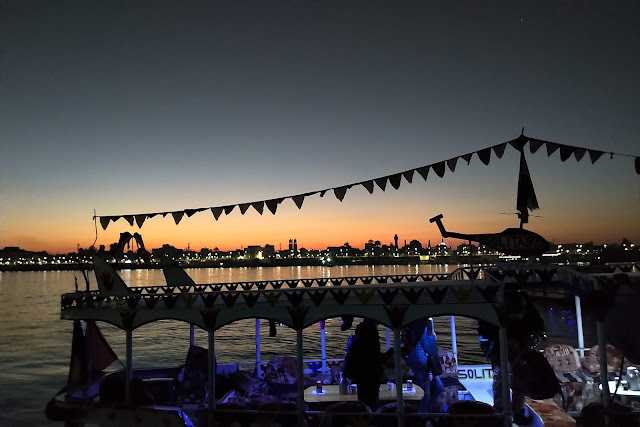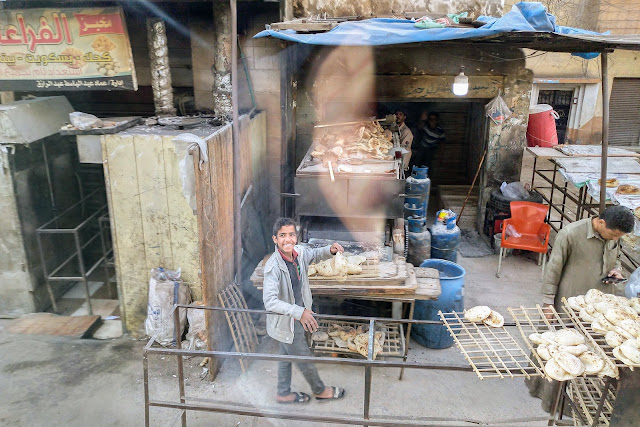Valley of the Kings
February 26: Balloon ride, Valleys of the Kings and Queens
The ship spent the night docked in the city of Luxor, home to over 2 million. We joined about a quarter of our group for an early morning adventure leaving the ship at 05:15 for a sunrise hot air balloon ride. A short drive took us to the east shore of the Nile where we boarded an interesting boat for the short ferry to the west bank. A van took us to the launch area where a number of balloons were being inflated and loaded. We had 20 in our basket below the massive hot air ballon. (The largest baskets hold 32.) Our pilot, one of the most experienced in the area with over 3000 hours of flight time, took us to a height of 2000 feet to view the Valley of the Kings, Valley of the Queens, and the Temple of Hatshepsut.
Sunrise over the east bank of the Nile River
For almost an hour, we slowly rotated, changed altitudes, and drifted towards the Nile over lush farmers' fields, finally settling down gently behind a house. We met the rest of the Ramses group at their bus near the two giant Colossi of Memnon and continued to the Valley of the Kings where we visited 6 of the tombs including the most famous, the resting place of King Tutankhamen himself.
The Valley of the Kings is total desert surrounded by steep cliffs and completely devoid of any vegetation or water. The construction of the tombs is awesome and must have taken a massive amount of work to complete. The art on the walls and ceiling of the tombs is spectacular. So much of the colour from 3000 years ago is still visible. Building and decorating a royal tomb must have involved a massive amount of work by hundreds of highly skilled workers and artists. They started work on a king’s tomb as soon as he took the throne; those who ruled the longest had the most massive and elaborate tombs.
Tomb entrances to the right and left of the main walkway.
Tomb entrances to the right and left of the main walkway.
Photos within the tombs of the Pharaohs
We have not seen any boats like this on Lake Kawagama.
Prisoners with their arms tied behind them.
A powerful three-headed serpent, protection for the king against evil forces.
Tut's tomb was the smallest we visited, indicative of the fact that he did not live long after becoming pharaoh. Consequently, workers did not have a long time to enlarge and decorate his final resting place. The mummy of the king is displayed in his tomb, in a glass case, atmospherically controlled. Some of the wall paintings look like they are perhaps only decades old, not thousands of years old.
That Howard Carter had difficulty finding Tut's tomb is not surprising when one sees it’s location. It is built under the Tomb of Ramses V/VI and the rubble from the building of the upper tomb covered the entrance to the lower one. We heard that the water boy for the Carter expedition, while playing in the rocks, actually found the first stair that was carved for Tut's tomb. He ran to Carter recognizing that where there was one stair, more would be close by.
The long sloping tunnel that Carter found filled with rubble leading to the two rooms of the tomb. Unlike the other tombs, the entry tunnel is not decorated.
Images from within the tomb of Tutankhamen. His stone sarcophagus is surrounded by fresco-style paintings. These images are not carved into the wall indicating that the young king's death was unexpected and the workers did not have time to carve images before painting them. Baboons are shown on the wall to the right.
The long sloping tunnel that Carter found filled with rubble leading to the two rooms of the tomb. Unlike the other tombs, the entry tunnel is not decorated.
Images from within the tomb of Tutankhamen. His stone sarcophagus is surrounded by fresco-style paintings. These images are not carved into the wall indicating that the young king's death was unexpected and the workers did not have time to carve images before painting them. Baboons are shown on the wall to the right.
Remembering that these are burial places is difficult. With all their intricate and lovely artwork, they are more like galleries. Even going into Tutankhamen's tomb, with his mummified remains there to be seen, seems so different from visiting a modern cemetery.
After leaving the Valley of the Kings, we stopped briefly at an alabaster shop where artisans fashion items using the same kinds of tools that have been used for millennia.
Our last stop of the day was the Temple of Hatshepsut, one of the queen's of ancient Egypt. The temple is in the Valley of the Queens and is the most massive structure in the area. Her stepson, Tutmosis III, removed most of her images. He may even had had her killed, since she was in the way of him ascending to the throne.
Both valleys are dry and dusty. Today, no jackets were needed. The area must be like a reflector oven in the hot months with the light coloured steep rock walls reflecting the sun's heat onto those on the valley floor. The walking is not rough at all. Most people wore some kind of hiking shoe and some wore running shoes; boots are not needed.
We were back on board for lunch and a little horizontal time to make up for our dark and early start today. Dinner tonight was a buffet made up of Egyptian foods. Very tasty. Also, some of the passengers dressed in Egyptian garb, as is the tradition on this ship.
























Comments
Post a Comment